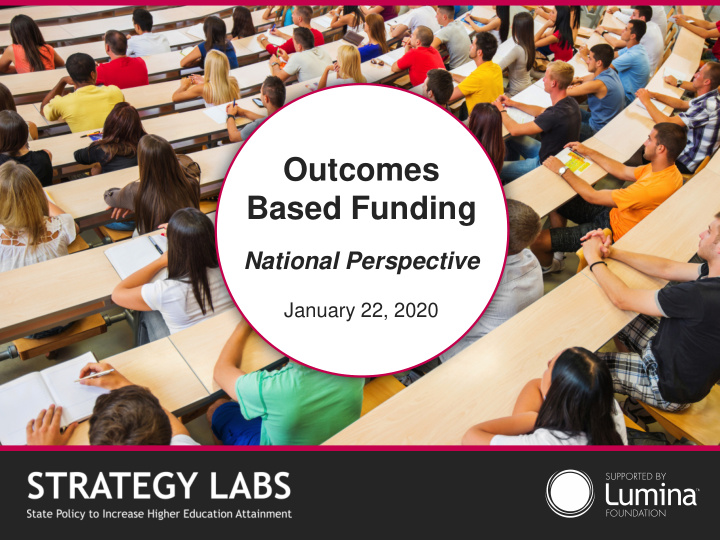



Outcomes Based Funding National Perspective January 22, 2020 StrategyLabs.LuminaFoundation.org
60% of adults with high quality degrees or credentials by the Year 2025 StrategyLabs.LuminaFoundation.org 1
Lumina’s vehicle for higher education system change Strategy Labs are an open platform for leaders and influencers in all 50 states to share research and data, encourage peer learning and provide opportunities for on-request support from Lumina Foundation and its state policy partners. StrategyLabs.LuminaFoundation.org
StrategyLabs.LuminaFoundation.org 3
History of Higher Education Funding Models • Base-plus funding – Linked to historic funding levels – Not tied to state goals and priorities – Lacks transparency • Enrollment-driven models emerged in 1960s – Linked to goal of increasing access – Tied to number of students enrolled – More predictable and transparent – Reduced political competition and lobbying 4 StrategyLabs.LuminaFoundation.org
History of Higher Education Funding Models (cont.) • Tennessee added a performance bonus to their enrollment model in 1978 – Many states followed. Became known as “performance funding” – Often there were design problems – Fell in and out of favor over next decades • Beginning 2009, several states reexamined these older funding methods that no longer aligned with state goals. – Began linking funding to student success, increased attainment, closing equity gaps – Adapted new models from what was learned from earlier models – This is “performance funding 2.0” or “outcomes-based funding” 5 StrategyLabs.LuminaFoundation.org
Outcomes-based Funding Theory • Aligns the state’s finance policy with state goals – Attainment, Equity, Workforce, Research, etc • Has the ability to influence institutions through: – Financial incentives – Awareness of state priorities – Awareness of institutional performance • Provides incentives to adopt and scale evidence- based student success practices StrategyLabs.LuminaFoundation.org
StrategyLabs.LuminaFoundation.org 7
Design Principles for Outcomes-Based Funding Begin with a state Use a simple and Include only goal/clear policy stable approach measurable metrics priorities Incent success of Account for typically Seek stakeholder mission of underrepresented input institutions students Make the money Phase-in Plan to evaluate Plan to evaluate meaningful (≠ Hold Harmless) StrategyLabs.LuminaFoundation.org 8
OBF Typology • State funding systems vary significantly in design, focus and sophistication. • HCM Strategists has developed a typology for Outcomes-Based Funding ranging from Type I (Rudimentary) to Type IV (Advanced). Type I • State does not have completion/attainment goals and related priorities • Reliant on new funding only • Low level of state funding (under 5%) • Does not differentiate by institutional mission • Total degree/credential completion not included • Outcomes for underrepresented students not prioritized • Target/recapture approach • May not have been sustained for two or more consecutive fiscal years StrategyLabs.LuminaFoundation.org 9
OBF Typology • State funding systems vary significantly in design, focus and sophistication. • HCM Strategists has developed a typology for Outcomes-Based Funding ranging from Type I (Rudimentary) to Type IV (Advanced). Type II • State has completion/attainment goals and related priorities Recurring/Base funding • • Low level of state funding (under 5%) • Does not differentiate by institutional mission • Total degree/credential completion included • Outcomes for underrepresented students may be prioritized Target/recapture approach likely • • May not have been sustained for two or more consecutive fiscal years StrategyLabs.LuminaFoundation.org 10
OBF Typology • State funding systems vary significantly in design, focus and sophistication. • HCM Strategists has developed a typology for Outcomes-Based Funding ranging from Type I (Rudimentary) to Type IV (Advanced). Type III • State has completion/attainment goals and related priorities • Recurring/Base funding • Moderate level of state funding (5 - 24.9%) • Differentiates by institutional mission, likely Total degree/credential completion included • • Outcomes for underrepresented students prioritized • May not be formula driven • Not sustained for two or more consecutive fiscal years StrategyLabs.LuminaFoundation.org 11
OBF Typology • State funding systems vary significantly in design, focus and sophistication. • HCM Strategists has developed a typology for Outcomes-Based Funding ranging from Type I (Rudimentary) to Type IV (Advanced). Type IV • State has completion/attainment goals and related priorities • Recurring/Base funding High level of state funding (25% or greater) • • Differentiates by institutional mission • Total degree/credential completion included • Outcomes for underrepresented students prioritized • Formula driven/incents continuous improvement Sustained for two or more consecutive fiscal years • StrategyLabs.LuminaFoundation.org 12
StrategyLabs.LuminaFoundation.org 13
StrategyLabs.LuminaFoundation.org 14
Effects of Outcomes-based Funding • Changes to academic policies and programs – Developmental education reform – Promotion of degree pathways • Changes to student support services to improve student outcomes – Increase number of advisors – Implement early alert systems and other data analytic tools – Introduce one-stop shops • Positive effects on degree production have been found if model is sustained. StrategyLabs.LuminaFoundation.org
Effects of Outcomes-based Funding (continued) • In IN and TN, the OBF model led to increases in: – Credit accumulation in both 2- and 4-year sectors (TN) – Certificate completion (TN) – Degree completion in both the 2-year (TN) and 4-year (IN, TN) sectors – Declaring and obtaining a high impact degree in the 4-year sector (IN) – Significant positive impact on many of these metrics for full-time low- income and underrepresented minority students. • STEM incentives in OBF models have been shown to be associated with the production of more STEM degrees. StrategyLabs.LuminaFoundation.org 16
Implementation Considerations • OBF should be a policy tool, not just a budget exercise • Provide support to institutions ‒ Analysis of institution specific outcome and funding data ‒ Funding formula summits ‒ Sharing best practices for increasing success ‒ Student success improvement grants • Track and address unintended consequences ‒ Monitor academic standards • Learning outcomes, faculty surveys, grade distributions, degree requirements ‒ Monitor student access ‒ Monitor funding volatility StrategyLabs.LuminaFoundation.org 17
StrategyLabs.LuminaFoundation.org Presented by Jimmy Clarke Senior Director of State Policy, HCM Strategists jimmy_clarke@hcmstrategists.com StrategyLabs.LuminaFoundation.org 18
Recommend
More recommend